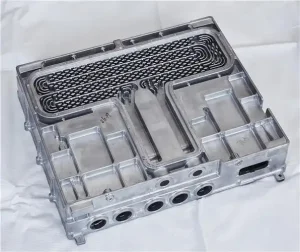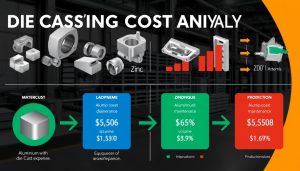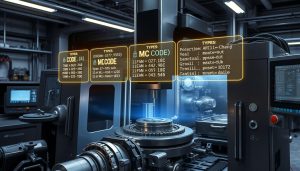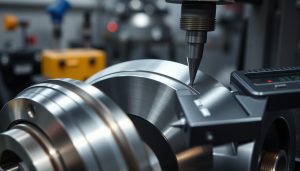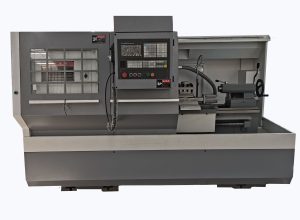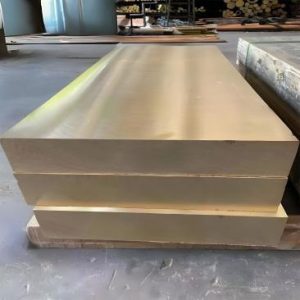In the world of modern manufacturing, CNC turning has emerged as a crucial precision engineering process that is transforming the way industries produce high-quality components. This article delves into the intricacies of CNC turning, exploring its definition, working principles, the benefits it offers, and the diverse applications it has across various sectors. By understanding the power of CNC turning, professionals in manufacturing, engineering, and related fields can gain valuable insights into this cutting-edge technology and its role in shaping the future of precision manufacturing.
What is CNC Turning?
Computer Numerical Control (CNC) turning is a cutting-edge manufacturing process that utilizes a computer-controlled lathe machine to shape and refine workpieces. This subtractive manufacturing technique involves removing material from a rotating workpiece to create the desired part or component. CNC turning is a highly precise and efficient way to produce a wide range of parts, from simple cylindrical shapes to complex geometries.
Definition of CNC Turning
CNC turning is a computerized machining process that uses a lathe to remove material from a workpiece. The computer controls the motion of the cutting tool, allowing for highly accurate and repeatable results. This process is particularly well-suited for producing parts with rotational symmetry, such as gears, shafts, and various other cylindrical components.
How CNC Turning Works
In CNC turning, the workpiece is securely mounted on a lathe and rotated at a specific speed. A computer-controlled cutting tool then moves along the workpiece, removing material in a precise, controlled manner. The computer’s programming determines the tool’s path, depth of cut, and other parameters, ensuring a consistent and accurate final product.
Difference Between CNC Turning and Other Machining Processes
While CNC turning is a type of subtractive manufacturing, it differs from other machining processes, such as milling or drilling, in several key ways. CNC turning focuses on removing material from a rotating workpiece, whereas milling and drilling operate on stationary workpieces. This allows CNC turning to produce parts with a high degree of precision and finish quality, making it a versatile and widely-used manufacturing technique.
| Feature | CNC Turning | Milling | Drilling |
|---|---|---|---|
| Workpiece Movement | Rotating | Stationary | Stationary |
| Tool Movement | Linear | Rotational | Linear |
| Typical Applications | Cylindrical parts, shafts, gears | Complex shapes, flat surfaces | Holes, openings |
“CNC turning is a highly efficient and versatile manufacturing process that allows for the production of a wide range of parts with exceptional precision and repeatability.”
CNC Turning Process Explained
At the heart of CNC turning is a precise and efficient process that transforms raw materials into high-quality parts and components. This step-by-step breakdown delves into the intricacies of the CNC turning workflow, highlighting the key elements that make it a versatile and valuable manufacturing technique.
Step-by-Step Breakdown of CNC Turning
- Programming the CNC lathe: Skilled operators create detailed programs that instruct the CNC lathe on the precise movements and actions required to shape the workpiece rotation.
- Workpiece setup: The raw material, or workpiece, is securely mounted on the lathe’s chuck, ensuring stability and precision during the machining process.
- Tool selection: Specialized cutting tools are chosen based on the material and desired finish, allowing for efficient and accurate material removal.
- Machining operation: The CNC lathe executes the programmed instructions, precisely shaping the workpiece through a series of cutting, turning, and finishing passes.
- Quality inspection: The finished part undergoes thorough inspection to ensure it meets the required specifications and tolerances.
Machines Used in CNC Turning
CNC turning operations are typically performed on specialized CNC lathes, which are computer-controlled machines designed to shape and finish parts with exceptional accuracy and repeatability. These versatile machines can handle a wide range of materials, from metals and plastics to composites, making them invaluable tools in various industries.
Types of Materials Used in CNC Turning
The CNC turning process is compatible with a diverse array of materials, allowing manufacturers to produce a vast array of parts and components. Some of the most common materials used in CNC turning include:
- Metals: Aluminum, steel, stainless steel, titanium, and other alloys
- Plastics: Acrylic, polycarbonate, nylon, and engineering-grade thermoplastics
- Composites: Fiber-reinforced plastics and carbon fiber-based materials

“CNC turning is a versatile manufacturing technique that allows us to create highly precise and complex parts across a wide range of industries.”
Benefits of CNC Turning
CNC turning offers a myriad of advantages that make it an increasingly popular choice for modern manufacturing. From exceptional high precision to enhanced rapid prototyping capabilities and cost-effective mass production, this advanced machining process delivers unparalleled benefits across various industries.
Precision and Accuracy in Production
One of the primary advantages of CNC turning is its ability to achieve remarkably high levels of precision and accuracy. With the use of computer-controlled machinery, CNC turning ensures that each part is manufactured to the exact specifications, reducing the need for extensive post-processing and ensuring consistent product quality.
Speed and Efficiency
The automated nature of CNC turning significantly boosts production speed and efficiency. By streamlining the manufacturing process, CNC turning enables rapid prototyping and quick turnaround times, allowing businesses to respond swiftly to market demands and stay ahead of the competition.
Cost-Effectiveness for Various Production Runs
CNC turning is a highly versatile machining process that is equally cost-effective for small, medium, and large production runs. Whether you require a few custom parts or need to manufacture components in high volumes, CNC turning can optimize your costs and deliver consistent, high-quality results.
“CNC turning has revolutionized the way we approach manufacturing, offering unparalleled precision, speed, and cost-effectiveness – key factors that have made it an indispensable tool in today’s competitive market.”
Applications of CNC Turning
CNC turning has become a vital manufacturing process across various industries, thanks to its ability to produce high-precision components with exceptional efficiency. From the automotive sector to aerospace manufacturing and medical device production, CNC turning has proven to be a versatile and indispensable tool.
CNC Turning in the Automotive Industry
In the automotive industry, CNC turning plays a critical role in the fabrication of numerous components. From intricate engine parts to suspension systems, CNC-turned automotive components ensure the smooth operation and reliability of modern vehicles. The precision and speed offered by CNC turning enable automakers to meet the constantly evolving demands of the market, delivering high-quality automotive components at scale.
CNC Turning in Aerospace Manufacturing
The aerospace industry, with its stringent requirements for safety and performance, heavily relies on the capabilities of CNC turning. This process is instrumental in the production of a wide array of aerospace parts, including turbine blades, landing gear components, and aircraft structural elements. The unparalleled accuracy and consistency achieved through CNC turning are essential for ensuring the airworthiness and reliability of these critical components.
CNC Turning for Medical and Industrial Parts
Precision and cleanliness are paramount in the medical device industry, and CNC turning excels in this regard. From surgical instruments to prosthetic components, CNC-turned medical devices are manufactured to exacting standards, ensuring patient safety and optimal performance. Additionally, CNC turning is widely utilized in the production of industrial parts, where dimensional accuracy and repeatability are of the utmost importance.
The versatility and capabilities of CNC turning have made it an indispensable tool across a vast range of industries, from automotive and aerospace to medical and industrial manufacturing. As technology continues to evolve, the role of CNC turning in shaping the future of these sectors is poised to grow even more significant.

Contact Shixinproto for Reliable CNC Turning Services
When you need precise, high-quality CNC turning services, Shixinproto is the partner you can rely on. With state-of-the-art equipment and a commitment to excellence, the team at Shixinproto specializes in producing custom-manufactured parts for a wide range of industries, from automotive to aerospace.
Shixinproto’s CNC turning capabilities allow for the creation of intricate, dimensionally accurate components that meet the most stringent quality standards. Their experienced engineers work closely with clients to understand their unique manufacturing needs and deliver tailored solutions that exceed expectations.
Whether you require small-batch production runs or large-scale orders, Shixinproto’s CNC turning services guarantee precision, efficiency, and cost-effectiveness. Discover how their expertise in CNC turning can elevate your custom manufacturing projects by contacting them today.
